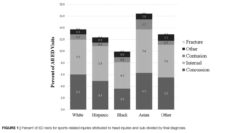Occasionally, I experience migraines with aura, which means neurological symptoms accompany the headache: difficulty decoding written words, pixelated vision, difficulty speaking, body numbness. My first migraine came when I was a teenager, and I went to the hospital thinking I was having a stroke. Although each attack is a little different, I always get the aura first. Then, a piercing headache and a steady loss of clear thinking: sometimes I can’t recall family members’ names. I dread the day I forget my own.
Migraine (with or without aura) has been ranked the seventh leading cause of years of life with disability worldwide. It is three times more prevalent in women than men in the United States, highest during reproductive years are likely due to fluctuating estrogen levels. Compared to men, women also report longer migraine duration, recovery period, and overall greater disability from migraines.
Between 20% and 40% of women use their obstetrician/gynecologist as their primary care doctor, yet very little is known about migraine knowledge and practice patterns among these providers. Allison Verhaak and her team conducted an online survey among 115 clinical providers who specialize in women’s sexual and reproductive health, including physicians, residents, nurses, Advanced Practice Providers, and midwives. The survey asked the providers about their knowledge of migraine diagnosis and treatment, including questions related to hormone therapy.
They found that almost 83% of respondents felt comfortable diagnosing migraine, but only 58% routinely asked patients about headaches during annual visits. Respondents knew little about evidence-based, non-pharmacological treatments for migraine such as cognitive behavioral therapy. Only 37% of respondents reported that they had been trained to treat headaches, including migraines. Very few (6.3%) were familiar with standard guidelines on migraine prevention.
What providers don’t communicate, a patient won’t easily discover on their own. I had never heard the term “aura” until reading the results of Verhaak’s article, despite multiple reviews of medical history with providers over the years. Without a name for what I experienced, it was harder to do my own research or know what questions to ask. I might have understood sooner, as 92% of providers did, that hormonal fluctuations can trigger these types of migraines. I might have learned that some of the medications I’d taken for years are not recommended for patients like me.
I have always told my doctors about my “stroke-like symptoms,” but was never given the information I needed. Unfortunately, this is a common experience for many women, who often must educate themselves and their health care providers. After hours of mind-numbing review of medical journal articles, I went back to my primary care physician with my concerns.
Once I had a name for my experiences and knew which questions to ask, more pieces of the puzzle emerged. I learned about mental health conditions associated with migraines with aura, which I have struggled with for years. I learned that most migraine studies are far too general and don’t differentiate between types of migraines.
Verhaak and her team recommend additional education around migraine management among women’s health care providers to improve patient care.
Verhaak and her team recommend additional education around migraine management among women’s health care providers to improve patient care. As if responding to her recommendation, in July 2022 England’s NHS announced a new women’s health strategy to address data gaps, treatment gaps, and the persistent need for women “to advocate for themselves.” This will primarily consist of compulsory women’s health training for medical students and primary care doctors.
But keeping the focus trained on doctors obscures the bigger picture. In the U.S., women of childbearing years were excluded from early clinical drug trials, exacerbating knowledge gaps in women’s health. A 1993 law sought a remedy by mandating that women and minorities be included in medical research funded by the National Institutes of Health. But knowledge and funding gaps persist, especially when it comes to women’s pain.
This past August, I met with my doctor and we adjusted my medication plan, although the research base was limited and the risks unknown. I eagerly await more research results, and a reliable system of communicating the outcomes of clinical trials to patients. Until then, the full picture remains murky for many suffering from disabling migraines.
Photo via Getty Images














